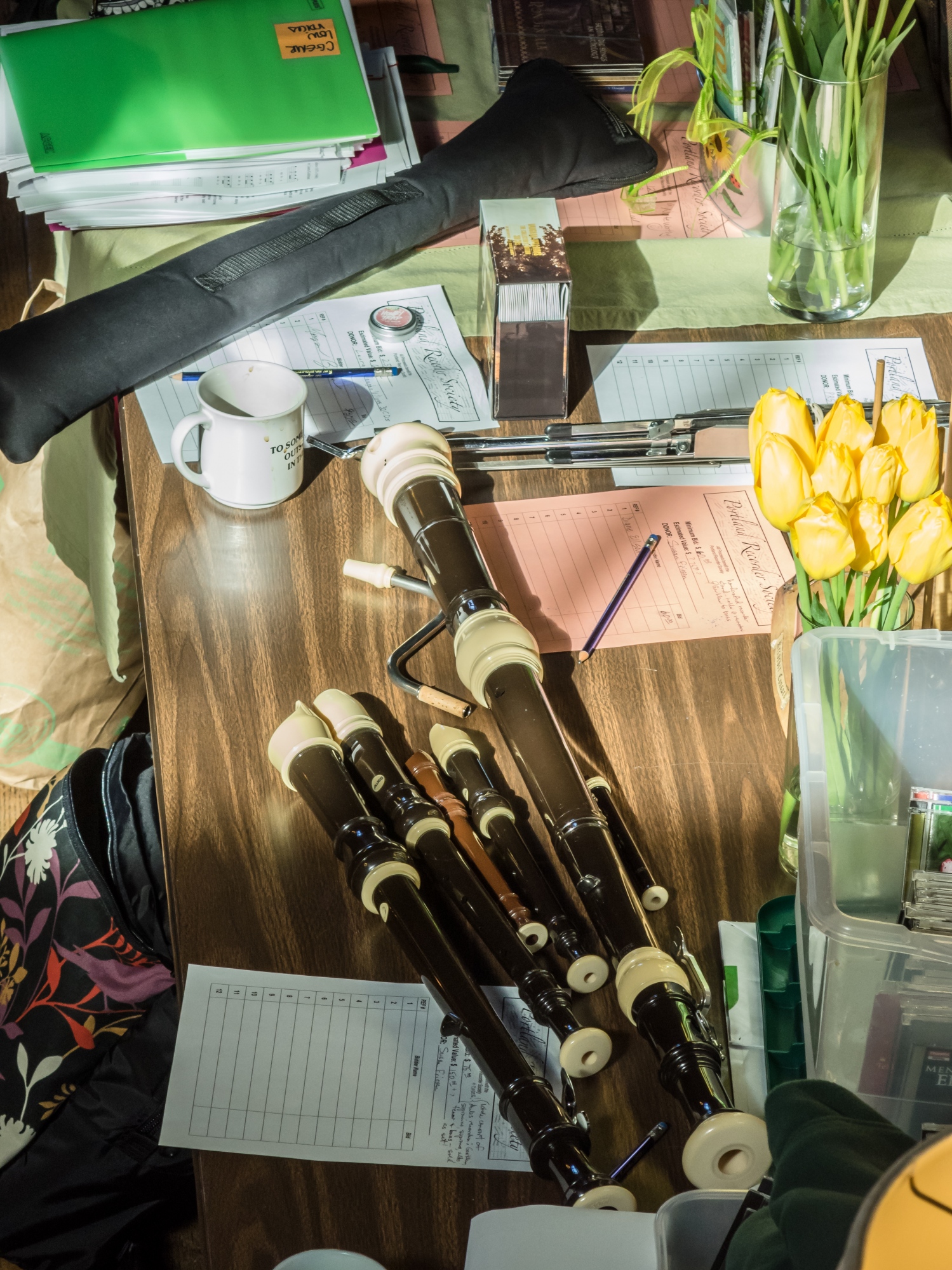Practice Project
Welcome to the American Recorder Practice Project!
Don’t you love playing the recorder? It’s fun, though you might suspect that if you played a little better it would be even more fun. Do you have a second? Let’s find out a bit more.
- First, finish this sentence in your head: “As a recorder player, my biggest weakness is ___________.” This is the thing that, if you fixed it, you’d become 100 times better.
- Next, think of a technical thing or two you’ve always wanted to be able to do on the recorder. You’ve heard someone do it in concert—a particular kind of ornament, articulation, scale or fast passage.
- Last, is there a piece you’d love to play, but right now it’s just too hard? It’s been on your wish list for a while. Maybe it exposes your biggest weakness, or features a lot of those technical things you can’t do yet.
If you have an answer for any of these questions, it sounds like you might have some hidden goals. Goals are good—they make life interesting. Just saying: if you practiced better, you’d be a lot closer to meeting those goals. My goal is to help you meet yours. In fact, this page is the gateway to a series of tools for you; it functions as a No Blame Zone for recorder players to find out what works, and what doesn’t, when you practice.
The American Recorder Practice Project offers you
- Four articles for recorder players (Winter 2018 to Fall 2019 issues), all about different aspects of practicing
- A chance to hang out: newsy info about people, books, techniques and ideas; interviews with and articles about professional recorder players and teachers
- Videos where brave amateur players explore practice hacks
To get you in the mood:- RUN AN EASY SELF-DIAGNOSTIC: keep a week-long practice log like the one that appears at the end of the first article in the Practice Project series (in your Winter 2018 American Recorder). For the next seven days, commit to picking up your recorder with the simple goal of playing for 30 minutes a day. It doesn’t matter what you play: play old favorites, sight-read, play tunes by ear, work on concert pieces, just make music—and keep track of how it goes: https://americanrecorder.org/docs/ARwinter18_practice_project.pdf
Did it tell you more about your musical strengths and weaknesses?
Do you agree with everything he cautions you about?
I: The four articles in the
Practice Project, published in
American Recorder (starting with the Winter 2018 issue and concluding with Fall 2019) look at some of the many issues connected to good practicing. Topics include:
- Making self-evaluation less painful and more productive
- SHMRG: a fun and functional way to analyze music
- Practice hacks for fun and profit
- Creative Problem Solving 101
- Anxiety is your friend. Yes, it is.
- How the Alexander Technique helps you trill faster
- Practicing smart: how do brain and fingers interact?
Read article #1,
“Practice Makes Perfect? Nah (But it does a heck of a lot of other things), at:
https://americanrecorder.org/docs/ARwinter18_practice_project.pdf. It presents a cheerful dissection of the whys and wherefores of practicing the recorder.
"
Solving Technical Problems, With a Definitive List of Practice Hacks*"
article #2 is at:
https://americanrecorder.org/docs/ARspring19_practice_project.pdf. It helps you identify and address technical issues, and includes a workbook where you can make notes on each new piece of music, using an analysis tool called
SHMRG.
(Not sure what
SMHRG is?
Visit
http://tinachancey.com/the-practice-project for Tina’s audio intro to
SHMRG.)
Article #3 covers problems other than musical ones that may keep you from practicing effectively:
"When Practicing Well Still Doesn't Do It—These Extra-Musical Suggestions May Make a Difference," https://americanrecorder.org/docs/ARsum19_practice_project.pdf. Article #4, "The Practice Project: How to be a Bulletproof Recorder Player,” describes how research from other disciplines provides data on how to practice smart, so that we can play spontaneously, yet with control and confidence. Included in this article are an interview with
Noa Kageyama, the legendary Bulletproof Musician,
https://bulletproofmusician.com/blog; and an excerpt from an interview with Dr. Serap Bastepe-Gray, conducted by
Stay Thirsty Magazine,
https://staythirstymagazine.blogspot.com/p/johns-hopkins-music-mediciine.html. Read this article in
American Recorder at
https://americanrecorder.org/docs/ARfall19_practice_project.pdf.
II: Want to hang out?We prime the pump with a rehash of my first Facebook discussion of everyone’s favorite practice shortcuts, from August 2017 (bottom left at the following URL:
http://tinachancey.com/the-practice-project).Read about an intro to the best tool you’ll ever have for figuring out how to play the music you love,
SHMRG. Say what? Visit
http://tinachancey.com/the-practice-project for Tina’s audio introduction to
SHMRG.
Also on the same page, Laura Osterlund played recorder in an exciting but grueling six-week run of a play about Nell Gwynn at the Chicago Shakespeare Theater. How did she prepare for it and get through that? Read an interview with her.
III.
Videos at https://www.youtube.com/americanrecordermagFor these videos, I asked recorder players from the Washington, D.C., area to bring in questions that preoccupy them for us to discuss and experiment with, questions like (partial list):
- What use is SHMRG anyway?
- How can I sight-read faster and better?
- Tell me all about Baroque ornaments, beginning to advanced.
- How does articulation create musical character?
- What’s the difference between a good student performance and a professional level one?
… and more.
Video #1 features David McGown, who is wondering what
SHMRG is and how it’s going to make his playing better. We experiment using everyone’s old favorite, Handel’s C major sonata. (Click
https://americanrecorder.org/docs/AR1903PracticeProject_HandelSonata_video1r.pdf for a PDF of the Handel sonata.)
#2 and #3 feature Deborah Roudebush geeking out on ornaments.
#2 About ornaments, part 1: Follow along as we discuss the purpose and the elements of ornamentation, using as our example an Allemande by Michel de la Barre. Try adding these ornaments yourself:
https://americanrecorder.org/docs/AR1906_Allemande_by_De_la_Barre.pdfThis video "sets up the landing" for the second video, which delves further into ornamentation.
#3 How to practice those ornaments, part 2: Anyone who speaks a second language knows that it's not enough to pronounce the words right; you have to know how they fit together in a sentence to create meaning. Deborah Roudebush approaches the new language of French Baroque ornaments with common sense and imagination, and I add a drop of French champagne as a catalyst. The second video goes into more depth as we discuss how to practice this new syntax and how to have a target to improve.
#4 Rachel Isaacson wonders: Is it Angry Birds? Or Grumpy from the Seven Dwarfs? Rachel hears the opening motive of this
Alla Breve as angry. How do you express that and stay in context: keep the music in French Baroque style? And if that's your starting point, where do you go with it as the piece develops? In this
Alla Breve by Nicolas Chédeville, it's also important to remember that it's in cut time—so sometimes it's perky. Follow along with this PDF:
https://americanrecorder.org/docs/AR1906_Alla_Breve__Nicolas_Chedeville.pdf.We decide that the articulations make all the difference—but do little changes really make a big difference? For the more on the inside story about recorder articulation, read Scott Reiss's article in the January 2006 American Recorder,
https://americanrecorder.org/docs/ARjan06_ArticulationReiss.pdf. In #5, I interrupt Steve Mullany's excellent student performance of the Stick Dance by Béla Bartók (from
Romanian Folk Dances, 1915), with the goal of taking him to the next level. First I offer a number of pesky interpretive ideas that rock his world. But does it end up sounding better? More professional, perhaps? Really? How? Do you bend or roll your thumb? When do you blow, as you move your thumb–and how do you coordinate your tongue? Do you practice so that it will sound the same every time? Or do you practice to be ready to listen to and play with the other performers? Get down and get dirty, as you follow along:
https://americanrecorder.org/docs/AR1906_Stephen_Mullany--_Stick_Dance_by_Bela_Bartok.pdf.In video #6, Michael Pierce and I use four very different pieces to tackle the elements of sight-reading. On the page, music doesn’t always look like it’s supposed to sound. Follow along in the music by downloading your copy at
https://americanrecorder.org/docs/AR1909_Practice_Project_Sightreading.pdf. In order to make the notes easier to read, publishers often distort the measure so the beats don’t look equal. Some pieces are hard to read because the lines are too close, arbitrary articulations crowd the page, or other helpful editorial additions get in the way. What can you use to make it all come together more easily? Michael wonders if rhythm is the key.
In #7, not content to leave well enough alone, Robin Wilson and I revisit ornamentation, both French Baroque note ornaments and Renaissance line ornaments; specifically, slurring, articulation and note stress.
#8 lets Ellen Farrell do some long-term planning: organizing her practice to develop skills like coordinating tonguing and fingers on fast passages, playing in keys beyond one or two flats or sharps, and getting away from the printed page. It’s all about creating personalized learning modules that work for you. Follow along in the music at
https://americanrecorder.org/docs/AR1909_Division_flute7.pdf.
That’s it—keep playing, and to play your best, keep practicing! Visit the
Practice Project community forum page at
http://tinachancey.com/the-practice-project for information and inspiration. Have fun and stay in touch!
Tina Chancey





